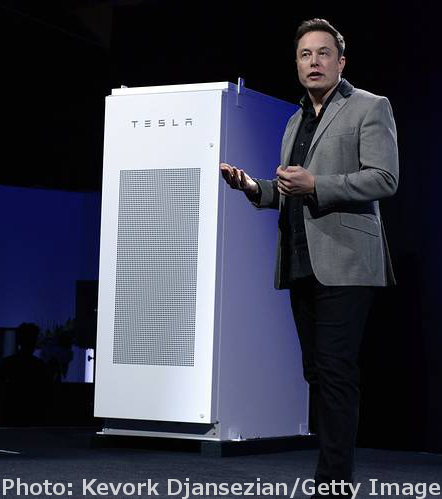Tesla takes up SA power strain
 A giant lithium ion battery will be installed in South Australia under an agreement between electric car and renewable energy company Tesla, French renewable company Neoen and the State Government.
A giant lithium ion battery will be installed in South Australia under an agreement between electric car and renewable energy company Tesla, French renewable company Neoen and the State Government.
SA Premier Jay Weatherill says the planned Hornsdale Power Reserve will become the state’s largest renewable generator, while the lithium battery will be the biggest in the world.
“South Australian customers will be the first to benefit from this technology which will demonstrate that large-scale battery storage is both possible and now, commercially viable,” he said.
Financial details remain unknown, but Neoen deputy CEO Romain Desrousseaux says his company will provide all the equity for the project, and seek bank finance once it is up and running.
Over the weekend, acting Prime Minister Barnaby Joyce dismissed the project as being too small to make a difference.
“It's a good idea but the capacity is not there,” Mr Joyce told ABC TV on Sunday.
“You know, a grain of sugar is an advantage to a teaspoon, but it doesn't make a hell of a lot of difference.”
Mr Weatherill criticised the negative federal reaction.
“Don't say anything if you can't say something positive,” the premier told reporters.
“I think anybody who was actually looking at this objectively would say it was a great idea.”
Some of Australia’s most informed experts have welcomed the announcement.
“The awarding of a 129 MWh battery contract to Tesla is big news for South Australia, as it will be able to instantly provide power to the grid when needed, as well as taking out any fluctuations in generating capacity from surrounding wind farms and PV installations,” says Dr Christopher Jones is National Secretary, Australian Electric Vehicle Association (AEVA).
“The battery will supply close to 10 per cent of the state's energy needs for almost an hour. It might seem like a drop in the energy demand ocean, but it's the first of many drops.
“Storage has long been the missing link for renewable energy, and coupled with developments such as pumped hydro in the Snowy Mountains scheme, will make a significant contribution to Australia's greenhouse gas reduction commitments.”
Professor Hugh Saddler from the Crawford School of Public Policy at the Australian National University agrees it could be the start of something big.
“The battery installation will make an important contribution to increasing the security and reliability of electricity supply in South Australia,” he said.
“It should also help to keep a lid on wholesale electricity prices, by making it more difficult for gas generators in the state to drive prices up to extreme levels by what is called strategic re-bidding behaviour.
“Frequent, very short lived extreme price spikes are a major cause of the super high average wholesale prices, for which all South Australian electricity consumers are now paying.
“The project is indirectly underwritten by electricity consumers in the ACT, who are paying for all the output of the Hornsdale windfarm, as part of the ACT’s move to 100 per cent renewably sourced electricity by 2020.
“In that sense, it represents a partnership between the governments of South Australia and the ACT.”
Dr Ariel Liebman, Deputy Director of the Monash Energy Materials and Systems Institute (MEMSI) at Monash University, says there is still a long way to go.
“Today’s announcement about the Neoen and Tesla investment in a 100MW/129MWh battery adjacent to the Hornsdale wind-farm in South Australia is groundbreaking and clearly foreshadows the shape of the Australian energy future. I welcome this exciting announcement which will be remembered as the first large scale proof-of-concept on the National Energy Market transformation path,” he said.
“However, we shouldn’t get too complacent because there are still significant challenges in turning this kind of activity into business-as-usual.
“We still don’t have a National Planning Framework, as pointed out by last month’s Finkel Review. We need a new paradigm in system planning, where we are able to make efficient investment decisions in a nationally coordinated fashion over at least a 20 to 30 year horizon.
“Failing to take such a national approach will likely result in billions of dollars of stranded assets as different technologies unexpectedly emerge as competitive at various locations at different points in the future.
“The current NEM market design cannot efficiently incentivise investment over the required horizons.”







 Print
Print